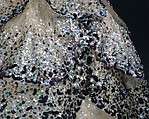"Junon"
Couture Line House of Dior French
Designer Christian Dior French
Not on view
By 1949, Christian Dior's instinct for calibrated innovations of the body's "line" had established him as fashion's preeminent arbiter. That year, dresses called "Venus" and "Junon," or Hera to the Greeks, were among the most coveted of his designs. Dior's Venus was realized in the delicate eighteenth-century gray that was his signature, frosted with iridescent beading and embroidery. But his Junon is more vividly conceived. The magnificent skirt of ombréed petals, like abstractions of peacock feathers without their "eyes," obliquely references the bird associated with the Queen of the Olympians. Emanuel Ungaro's classical gown (1993.345.15a-c), like the magnificent peplos and capacious himation befitting the noblest Olympian goddess, is discrete in its coverage.
Current notions of classical dress are surprising in the breadth of their parameters. They are based in part on the original variations and manipulations of the antique models, the attributes accrued to it over time by artistic convention, and the twentieth-century adaptation of ancient methods to modern forms. That the dress of people two-and-a-half millennia in the past can imbue a design of today with the aura of myth and timeless beauty suggests that the classical mode, like Penelope's weaving, is continuous and without end.
Due to rights restrictions, this image cannot be enlarged, viewed at full screen, or downloaded.
This artwork is meant to be viewed from right to left. Scroll left to view more.






